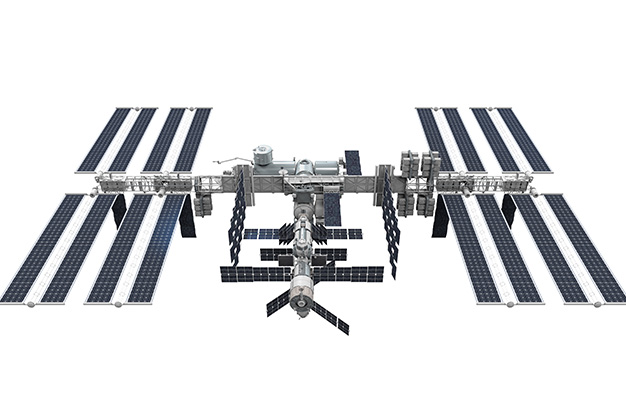“Serious damage to satellites, the International Space Station and other space craft is relatively rare. However, as the low Earth orbit region of space gets more crowded, collisions with space debris are estimated to increase tenfold in the next ten years.” – The CHACR turns its eyes to the skies to assess the threat posed by space trash to peace on Earth.
Read our latest In-Depth Briefing above, click here to download a copy direct to your desktop or keep reading below.
SPACE TRASH AND THE INCREASING THREAT TO INTERNATIONAL PEACE AND SECURITY
SPACE trash – or as NASA refers to it ‘orbital debris’ – poses a critical and widely overlooked risk to international peace and security. And it is becoming more acute as the world, characterised by challenges to international order and stability, can be increasingly understood through realist concepts of power, self-interest and an abject lack of supranational governance.
NASA consider there are up to 600,000 small (1-10cm) and very small ( greater than 1mm-1cm) objects in low Earth orbit and more than 100 million tiny pieces of orbital debris. Typically, this debris is caused by unwanted or damaged satellites and rockets, the results of space weapon tests, flecks of paint or accidentally discarded space station tools. The problem is most prevalent in low Earth orbit because this is the band of space where the International Space Station orbits and is likely to become critical for the transportation and resupply of many proposed future satellites and platforms.
The challenge is space trash travels at very high velocities (up to 15,000mph), which means the kinetic energy poses a “significant collision threat to both human spaceflight and robotic missions” and can cause catastrophic damage. On 12th May 2021, NASA discovered orbital debris had hit the International Space Station, leaving a hole in one of its robotic arms. While the arm remained operational, NASA also reported that numerous space shuttle windows needed to be replaced because of damage caused by high velocity flecks of paint.
Most concerning, NASA’s current surveillance network cannot effectively detect, track, or remove small, very small and tiny debris pieces. The most advanced technology in detecting small space debris involves radar systems, optical telescopes and data fusion algorithms. And while radar is a proven method to detect objects 10cm in size and larger, detecting and tracking smaller space debris is exceptionally challenging at present, primarily as small and very small space debris can have a microscopic radar cross-section and so poorly reflect any radar signal. Equally ‘space trash’ can be ‘non-Keplerian’, meaning it does not conform to normal orbital patterns (like planets or the Moon) and can change direction unpredictably. Commentators also note even if NASA could detect and track space debris, the challenge is a balance of the cost and benefit.
For example, ‘laser nudging’ employs ground-based or space-based lasers to push objects so they burn up in Earth’s atmosphere or enter a ‘graveyard orbit’, beyond the orbits of current operational satellites and spacecraft. However, these are best employed for ‘large’ objects of 10cm diameter or more. The fuel cost to manoeuvre space-based lasers and the scale of over an estimated half a million small or very small pieces of space debris, likely makes dealing with them unviable. Perhaps more concerningly, the $6 billion US ‘space fence’ simply detects only larger and seemingly more dangerous debris.
Fortunately, serious damage to satellites, the International Space Station and other space craft is relatively rare. However, as the low Earth orbit region of space gets more crowded, collisions with space debris are estimated to increase tenfold in the next ten years and will result in debris being pushed into the medium Earth orbit inhabited by global navigation satellite systems.
NASA’s concern is an increase in collisions will create even more debris and trigger a chain reaction known as the ‘Kessler syndrome’, which could make some vitally important orbital paths unusable and also restrict access to the more strategic medium Earth orbit. NASA’s aim is therefore not only about safeguarding incredibly expensive assets but also ensuring the long-term sustainability of space exploration and satellite operations. They consider “millimetre-sized orbital debris represents the highest mission-ending risk to most robotic spacecraft operating in low Earth orbit”. Such is the challenge, NASA is in fact offering $120,000 to anyone who can propose ways to solving the issues.
So, why is it a risk for international peace and security? On 15th November 2021, Russia conducted an anti-satellite test to destroy one of its old assets. In doing so, it created thousands of new pieces of debris, earning the condemnation of the National Space Society and forcing the seven-member crew of the International Space Station to shelter in an escape capsule in case they needed to evade the lingering debris cluster. At the time, General James Dickinson, head of US Army Space Command, said: “Russia has demonstrated a deliberate disregard for the security, safety, stability and long-term sustainability of the space domain for all nations.”
The anti-satellite test by Russia raised the spectre of a Star Wars-style conflict with national strategic assets, like global positioning and nuclear command and control satellites, being deliberately targeted. However, whilst there is some concern over the ability for countries to launch anti-satellite missiles (China, India, Russia and the USA have all done so), the fundamental risk of space debris to international peace and security is not centred on physical capabilities or space weapons, but on the international politics and the trend towards an anarchic international system.
“The security dilemma provides a theory of war and peace based on the interaction between states in which anarchy, uncertainty and fear influence behaviour and outcomes.”
Realists such as John Mearsheimer and Hans Morgenthau, drawing on themes that would resonate with Hobbes and Machiavelli, share the view that the world is characterised and shaped by a pessimistic view of an intrinsically selfish human nature. As a result, the international system is one of anarchy where states vie for power relative to others, in an attempt to survive and thrive. In this system, states are inherently suspicious and uncertain of the ambitions and intentions of others. Many conclude that being the most powerful is the best and only way to survive. This raises the spectre of the ‘security dilemma’.
The security dilemma, coined in 1950, recognises the zero-sum nature of the system and that attempts to increase the security of a state through defensive actions may be seen as hostile by a neighbouring state. The neighbouring state is then spurred into building their own security in response. This validates the initial defensive actions and encourages a spiral of hostility and escalation with each actor validating the fears of the other.
In his famous 1990 article, Back to the future, Mearsheimer predicted the end of the Cold War would provoke a period of multipolarity characterised by nationalism, ethnic rivalries, widespread conflict and instability. In recent times, China, Russia and the countries of the ‘Global South’ have sought to re-draw the rules-based international system which they see as enabling US hegemony, increasing suspicion, fear and regional and international instability. In The World: A Brief Introduction Richard Haas, former president of the US Think Tank Council on Foreign Relations, reinforces the underlying sense of global anarchy and the fragility of efforts to provide order: “Global order does not just emerge or continue automatically. Technocratic management is needed to protect a balance of power from the forces of disunity and violence, but is hard to sustain.”
And now entering this cauldron is space debris.
Let’s imagine for a moment that two unconnected events occur simultaneously. The first is a dramatic increase in tension between the USA and China. The second occurs 20,000km above the Earth as a previously unidentified, untracked and unverifiable particle, less than 1cm in diameter smashes into a critical element of an American positioning, navigation and timing satellite at 15,000mph.
This causes catastrophic damage to the satellite, US operational and strategic levels of command and, more than likely, the world economy. Public attention, fuelled by social media, quickly points the finger at a deliberate act by China, which NASA is unable to disprove quickly or categorically due to the inability to track small and very small items of space trash. In the context of daily cyber and infrastructure attacks conducted on Earth, it is both reasonable and believable for this to happen in space. The US President, under enormous domestic pressure, seeks to act defensively and preserve the security of the US military. China, innocent of damaging the US satellite, sees these actions as marked aggression and so begins a potentially destructive escalation.
The combination of orbital debris, global instability and “continued predominance of realist attitudes towards international and global security among many of the world’s political leaders” presents a unique challenge.
The dramatic increase in space trash over the next ten years jeopardises the long-term sustainability of space exploration and satellites. It also adds further uncertainty in an international system already characterised by mistrust and uncertainty and in an environment that does, and will increasingly contain, critical national infrastructure.
The probability is increasing of a collision caused by space debris, as is the gravity of such in space and on Earth. NASA’s competition to find ways to detect, track and remove debris in low Earth orbit, the results of which are announced on 13th December, is hopefully successful and actionable before a piece of space trash provides an unverifiable spark that results in a major conflict.





